Tampere
![]()
This article is about the city in Finland. For the Estonian folklorist and musicologist, see Herbert Tampere; for the asteroid, see (1497) Tampere.
Tampere [![]()
![]() ˈtɑmpɛrɛ] (Swedish Tammerfors [
ˈtɑmpɛrɛ] (Swedish Tammerfors [![]()
![]() [tamərˈfɔrs]]) is a major city in southwestern Finland. With 241,009 inhabitants, Tampere is the largest city in the Pirkanmaa region and the third-largest city in the country (after Espoo, which is part of the Helsinki agglomeration). Because of its diverse industry, it is often called the Manchester of the North (Finnish nickname: Manse).
[tamərˈfɔrs]]) is a major city in southwestern Finland. With 241,009 inhabitants, Tampere is the largest city in the Pirkanmaa region and the third-largest city in the country (after Espoo, which is part of the Helsinki agglomeration). Because of its diverse industry, it is often called the Manchester of the North (Finnish nickname: Manse).
In the Tampere metropolitan area, the population is 330,711 (as of 31 December 2016).
Tampere is the largest inland city in the Nordic countries.

Views of Tampere
Geography
Geographical position
Tampere is situated between two lakes, Näsijärvi and Pyhäjärvi. The lakes have a level difference of 18 metres and are connected by the 945-metre-long Tammerkoski Rapids, which is used as an energy source.
The city is approximately on a latitude with Söderhamn in Sweden and Lillehammer in Norway. On June 21, sunrise is at 03:41, sunset at 23:12. On December 22, on the other hand, the sun does not rise until 09:43 and disappears behind the horizon again at 15:04. The city is the centre of the Pirkanmaa region, also known as the Tampere region.
Distances to other Finnish cities:
| City | Distance | Point of the compass |
| Helsinki | 176 km | SSO |
| Jyväskylä | 149 km | NO |
| Kotka | 241 km | SO |
| Kuopio | 293 km | NO |
| Lahti | 126 km | SO |
| Lappeenranta | 274 km | OSO |
| Oulu | 476 km | NNO |
| Pori | 114 km | W |
| Turku | 157 km | SW |
| Vaasa | 242 km | NNW |
Extension of the urban area
The total area of the city is 690.6 km², of which 522.7 km² occupy land and 167.9 km² water areas. Since large parts of the urban area are rural, the population density is only 385 inhabitants per km².
Neighboring communities
Adjacent municipalities are Nokia and Ylöjärvi to the west, Pirkkala and Lempäälä to the south, and Kangasala and Orivesi to the east. As the area of the city extends very far to the north, Kuru and Ruovesi, whose local centres are already 70 to 80 kilometres away from Tampere's city centre, border there.
City breakdown
Tampere is divided into six municipalities, namely Keskustan piiri ('City Centre'), Läntinen piiri ('West District'), Pohjoinen piiri ('North District'), Itäinen piiri ('East District'), Eteläinen piiri ('South District') and Kaakkoinen piiri ('Southeast District').
The districts of Amuri, Pyynikki, Santalahti and Yläpispala, located west of the Tammerkoski rapids, straddle the Pispala ridge and belong to the Läntinen piiri, or western district.
To the north of the city centre are the districts of Lapinniemi, Lappi and Petsamo, and to the east Kauppi, Kaleva, Kissanmaa and Vuohenoja. Although they extend to the north, Kolunkylä, Kämmeniemi and Teisko belong to the eastern district.
Further south is the district of Hervanta, which belongs to Kaakkoinen piiri. Eteläinen piiri includes Härmälä, Hatanpä, Järvensivu.
Since 2011, the new Vuores district has been under construction to the west of Hervanta.
Climate
In January 2003, the average temperature was -11.4 °C, the maximum temperature was +4.8 °C and the minimum temperature was -32 °C. In July 2003, the average temperature increased to +20.2 °C, with the thermometer reaching a maximum temperature of +30.6 °C and a minimum temperature of +8.8 °C. The average amount of precipitation in 2002 was 500 mm.
| Tampere | ||||||||||||||||||||||||||||||||||||||||||||||||
| Climate diagram | ||||||||||||||||||||||||||||||||||||||||||||||||
| ||||||||||||||||||||||||||||||||||||||||||||||||
| Monthly average temperatures and precipitation for Tampere
Source: WMO | ||||||||||||||||||||||||||||||||||||||||||||||||||||||||||||||||||||||||||||||||||||||||||||||||||||||||||||||||||||||||||||||||||||||||||||||||||||||||||||||||||||||||||||||||||||||||||||||||
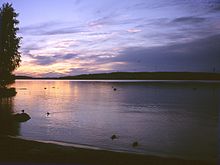
View of the lake Pyhäjärvi near Tampere
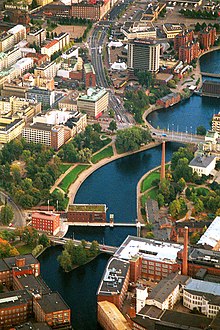
Tammerkoski flows through the city centre.
History
Already around 1000 the region was settled. From the 15th century there were manors and mills, in the 17th century a market place was mentioned for the first time.
On October 1, 1779, the present city was founded by the Swedish King Gustav III as a junction between Southern and Central Finland. The aim was to establish a new trading and factory town. Just a few years later, in 1783, the first Finnish paper mill was established here, and in 1820 the Scotsman James Finlayson founded a cotton mill on the then unused rapids between Näsijärvi and Pyhäjärvi, which became the foundation stone for the later textile industry and whose converted brick factory halls now house a number of museums, cafés and a cinema. Already in the 19th century Tampere was the Finnish innovation centre par excellence. In 1842 the first Finnish paper machine started production at the J. C. Frenckell & Son. factory, and in 1882 the first light bulbs in Scandinavia were produced at Finlayson.
The first railway line reached Tampere on 22 June 1876 from the direction of Hämeenlinna. A connection via Orivesi to Vaasa followed on 29 September 1883 and to Pori on 4 November 1895.
In 1865 a city fire raged in Tampere, but this did not stop the growth. As a result of strong industrialisation, Tampere was then the Finnish centre of the workers' movement at the beginning of the 20th century. In 1905 and 1906 Lenin attended Bolshevik conferences here.
Tampere was one of the strategically important cities during the Finnish Civil War (28 January to 15 May 1918). On April 6, the White forces captured about 10,000 Red soldiers during the capture of the city.
In 1923 Tampere became the episcopal see. During the Winter War, several Soviet air raids were carried out on the city, the heaviest of which involved 100 aircraft on 2 March 1940. Tampere was also attacked from the air during the Continuation War, with a total of 18 civilian deaths, as well as 1.2% of housing destroyed and 2.1% severely damaged. The 1960s saw the beginning of the decline of the textile industry, which was no longer able to meet the demands of the world market. From about 1970 onwards, the old factories were gradually closed down and used for other purposes.
Incorporations
Messukylä was incorporated in 1947, Lielahti in 1950, Aitolahti in 1966 and finally Teisko in 1972.
Population development
It is interesting to note that despite the economic restructuring in the 1970s, the city was never affected by out-migration and a resulting population decline, as was typical at that time, for example, in the similarly heavily industrialized cities of the Ruhr region.
Nevertheless, there are two phases in the history of the city that at least inhibited its growth. Besides the aforementioned period of economic restructuring, these would be the years of revolution and civil war.
Development of the number of inhabitants (from 1960 31 December):
| 1820 until 1904
| 1910 until 1987
| 1990 until 2003
|
Applies only to residents within the city limits. The urban settlement of Tampere has 281,092 inhabitants (estimate for 1 January 2005).
Of the 199,823 inhabitants on 31 December 2002, 104,540 (52.3%) were female and 95,283 (47.7%) male. Only 990 inhabitants, representing 0.5% of the total population, were Swedish-speaking.
| Population group | Proportion (1980) | Share (2002) | Share (2020) |
| 0-15 years | 20 % | 16 % | 16 % |
| 16-64 years | 67 % | 69 % | 64 % |
| over 64 years | 13 % | 15 % | 20 % |
The natural population development showed a birth surplus of 215 inhabitants in 2002. Net migration was also positive at 1,445 inhabitants. This development is due to the continuing urbanisation in Finland. For a comparison with the development in other large and medium-sized cities in the country, see the list of cities in Finland.
According to estimates, Tampere will have 229,000 inhabitants in 2020.
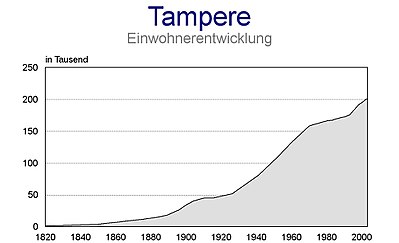
Graph of population development
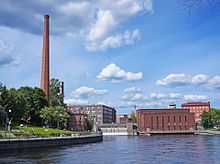
Industrial buildings on the Tammerkoski Stream
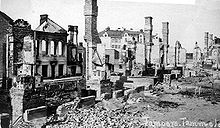
War damages 1918
Search within the encyclopedia